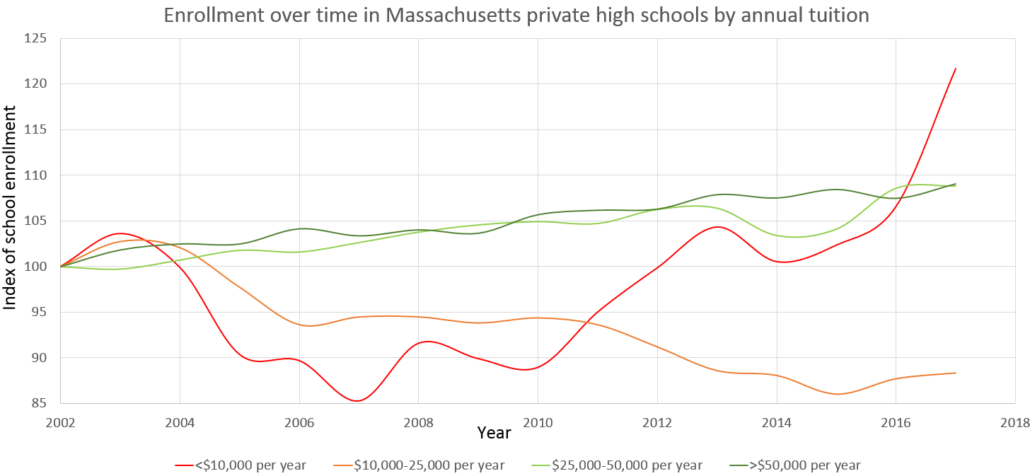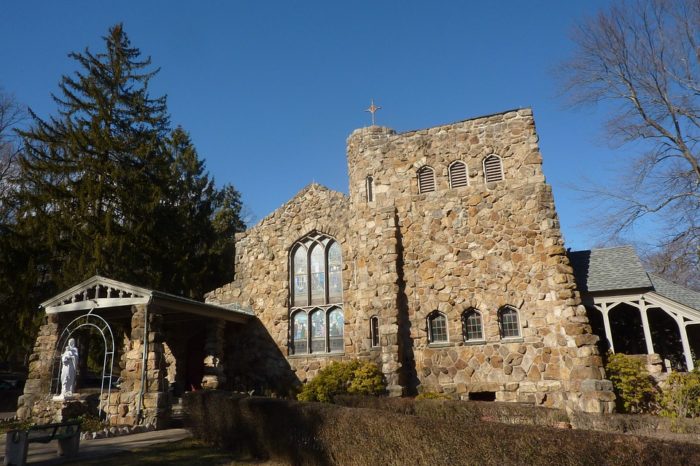Long-term decline in area Catholic high school enrollment is likely to continue
Over a dozen Catholic schools affiliated with the Archdiocese of Boston are governed by independent boards of trustees. Most of these schools offer programs to students in grades 9-12 (Figure 1). However, as private schools compete to attract talented students and, increasingly, traditional and charter public schools do the same, many Catholic schools are struggling to boost enrollment. Catholic school closings in Massachusetts have received significant media attention, but even those that have stayed open are challenged to generate sufficient tuition revenue and donations. With financial pressure to pay teachers, improve the infrastructure of aging buildings, and update technology and lab equipment, many parochial schools face major long-term obstacles.
Figure 1:
Boston Archdiocese-affiliated co-ed high schools and the grade levels they serve
| School | Grade level served |
| Archbishop Williams High School | 7-12 |
| Bishop Fenwick High School | 9-12 |
| Cardinal Spellman High School | 9-12 |
| Cathedral High School | 7-12 |
| Cristo Rey Boston High School | 9-12 |
| Lowell Catholic High School | Pre-kindergarten-12 |
| Marian High School | 9-12 |
| Matignon High School | 9-12 |
| Pope John XXIII High School | 8-12 |
| St. Mary’s High School | 6-12 |
Meanwhile, public schools and secular private schools have seen overall enrollment increases in the last 15 years (Figure 2). Demand for these private schools in the Boston area remains strong, and enrollment in non-Catholic religious schools has stabilized at slightly below 2002 levels. The analysis compares enrollment in Archdiocese of Boston schools to enrollment in public schools in the same communities as the Catholic schools and to secular, co-ed, non-specialty private schools in the same region. To facilitate comparability, the analysis only includes co-educational schools that enroll students in grades 9-12, as listed in an Archdiocese financial report. Figure 2 (and subsequent figures) express school enrollment as an index, with 100 representing 2002 school enrollment levels. Enrollment data is taken from a state database.
Figure 2:

Among Catholic schools that have remained open, enrollment has actually increased markedly in the last several years. This trend is largely due to expanding enrollment opportunities for primary education. Lowell Catholic, St John’s Prep in Danvers, Xaverian Brothers, and several other high schools have extended their services to younger children since 2014. Lowell Catholic High School’s new elementary-level program alone accounted for an increase of over 250 students between 2016 and 2017, largely driving the recent upward enrollment trend evident in Figure 2. Other kinds of specialty private schools, especially Montessori schools, are better at attracting younger children than high school students, and Catholic schools are increasingly fitting that niche as well.
Catholic schools have also invested in international student programs to help maintain fiscal stability, as tuition is generally higher for international students than for domestic students.
Overall, the relationship between tuition and enrollment changes seems to have a polarizing effect, with both low and high-cost schools tending to attract the most students (Figure 3). Among all private schools considered in the analysis, low-cost schools (with annual tuition less than $10,000) have had the greatest enrollment growth of any tuition category. However, enrollment changes in high-cost schools (annual tuition greater than $25,000) have been both positive and much more consistent over the period of study. Within this tuition category, there is little difference in enrollment growth between the most expensive schools (upwards of $50,000 in annual tuition) and the less expensive ones ($25,000-$50,000 in annual tuition).
Figure 3:

Meanwhile, the plurality of parochial schools in the analysis fall somewhere in between, with annual tuitions between $10,000 and $25,000. This category has overwhelmingly led the decline in Catholic school enrollment since 2002. One possible explanation is that private school applicants have prioritized either affordability or academic rigor to the extreme, with little room for compromise. Driven by rankings data and college preparedness reports, elite competitive private high schools tend to stay extremely competitive. Likewise, affordable schools tend to stay relatively affordable, attracting students from largely disadvantaged communities with under-resourced public schools. However, with rising tuition costs and increasingly competitive college admissions, the middle of the market for private high schools is quite vulnerable.
Still, many of the most affordable private schools are Catholic, and some evidence indicates that charter public schools have become a more appealing alternative to traditional public schools than parochial institutions are, because, absent the faith-based component, they offer many of the same benefits as parochial schools.
In the short run, expanding enrollment opportunities for younger children and international students will help Catholic schools stay solvent. Longer term, declines in religiosity and domestic migration trends will continue to cause mismatches between the location of Catholic schools and the location of Catholics. The result is that Catholic high schools in Massachusetts will likely continue to suffer ongoing enrollment challenges.
For more information on the state of Catholic schools in Massachusetts and America, read publications from Pioneer Institute’s Center for School Reform.
Andrew Mikula is the Roger Perry Government Transparency intern at Pioneer Institute. He studies economics at Bates College.



